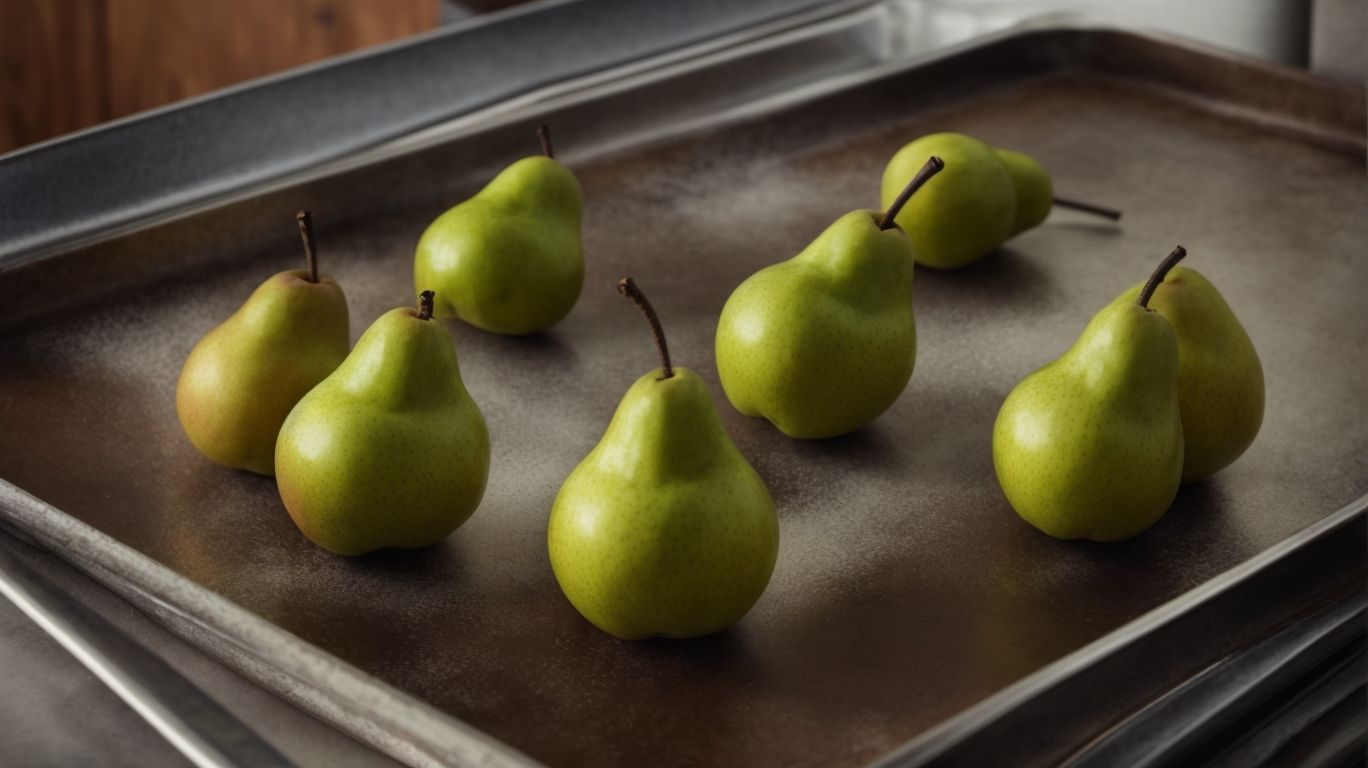How to Bake Unripe Pears?
Are you looking for a way to elevate your baking game?
Unripe pears might just be the secret ingredient you need to take your desserts to the next level.
We will explore the benefits of baking unripe pears, how to tell if a pear is unripe, the best types of pears for baking, and how to prepare them for the oven.
We’ll also share some mouth-watering recipes and tips to ensure your baked pears turn out perfectly every time.
So, grab your apron and let’s get baking!
Key Takeaways:
What Are Unripe Pears?
Unripe pears refer to pears that have not yet reached their optimal ripeness, often characterized by firmness and a lack of sweetness.
These pears typically have a pale green color and may still have hints of their original tanginess. The texture of unripe pears can be crisp and slightly gritty, different from the soft and juicy nature of ripe pears. Varieties such as Bosc, Anjou, and Bartlett can all be found in unripe states, each with its unique traits. While unripe pears may not be suitable for immediate consumption due to their lack of sweetness, they are versatile for use in cooking and baking, adding a subtle flavor and texture to dishes.
Why Bake Unripe Pears?
Baking unripe pears can transform their texture and flavor, turning them into delicious treats suitable for various recipes and occasions.
When unripe pears undergo the baking process, they become caramelized and tender, intensifying their natural sweetness. The addition of cinnamon enhances the warm, comforting aroma that fills the kitchen while the maple syrup adds a rich, velvety sweetness that complements the fruit perfectly. Once baked, these pears can be enjoyed on their own as a simple dessert, or they can be paired with toppings like chopped pecans for added crunch and flavor.
Enhance Flavor
Baking unripe pears can significantly enhance their natural flavor profile, unlocking new taste dimensions through the caramelization process.
When baking unripe pears, the heat from the oven evaporates the moisture inside the fruit, concentrating its sweetness. The addition of cinnamon offers a warm, aromatic undertone that complements the pears’ subtle tartness. Honey acts as a natural sweetener, providing a luscious caramelized coating on the fruit. Vanilla extract brings a rich, floral note that rounds out the flavor profile.
To create a delectable pear dessert, slice the pears, drizzle them with the honey-cinnamon-vanilla mixture, and bake until tender yet slightly crispy on the edges. These simple instructions will result in an irresistible dish that showcases the best of fall flavors.
Soften Texture
Baking unripe pears helps soften their texture, making them tender and enjoyable to eat in various culinary applications.
When pears are not fully ripe, their flesh can be too firm and lack the desired sweetness that comes with maturity. By baking them, the heat gently breaks down the cell walls of the fruit, resulting in a softer consistency that is easily digestible. Incorporating ingredients like butter during the baking process not only contributes to flavor but also aids in achieving a moist and silky texture. Nuts such as pecans and walnuts can provide a delightful crunch and nuttiness, complementing the softened fruit perfectly.
Use in Recipes
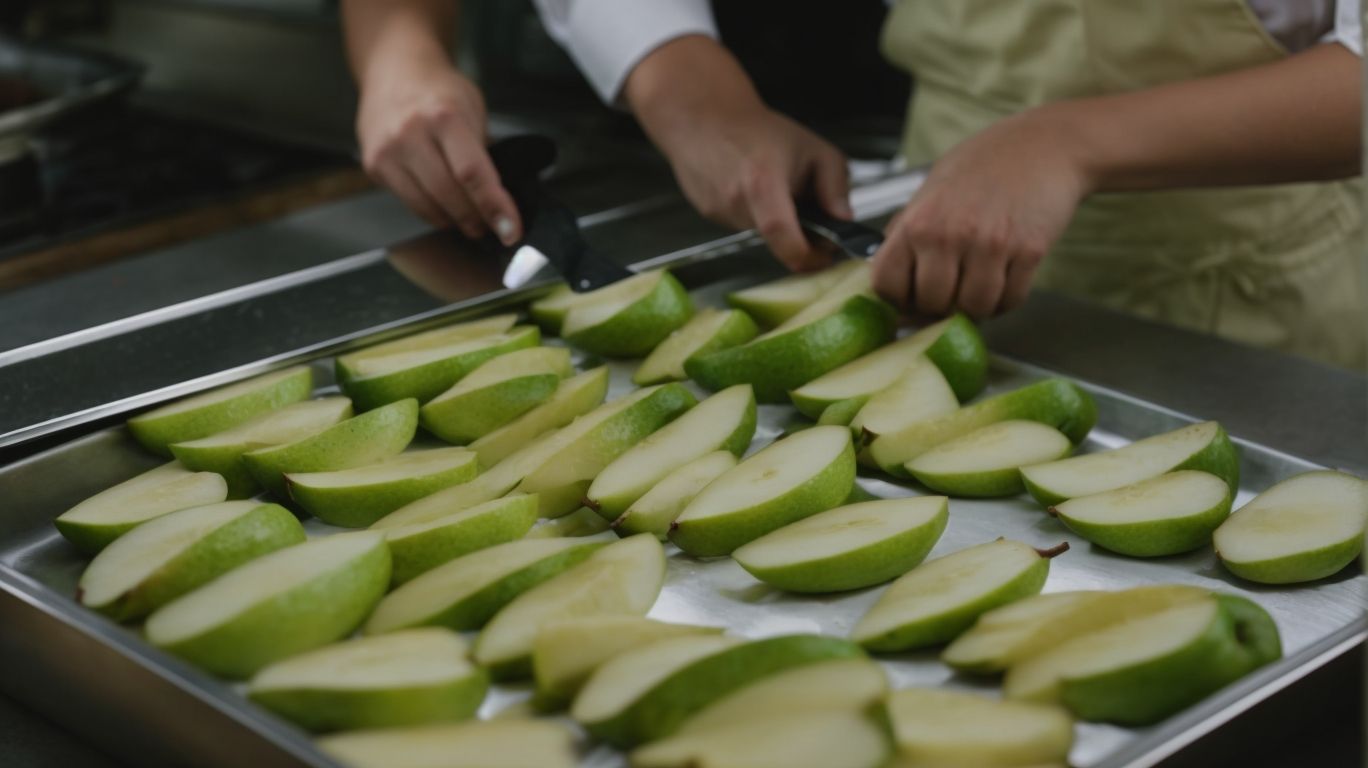 Credits: Poormet.Com – Bryan Taylor
Credits: Poormet.Com – Bryan Taylor
Baked unripe pears can serve as versatile ingredients in a wide range of recipes, adding a unique flavor and texture to both sweet and savory dishes.
How to Tell if a Pear is Unripe?
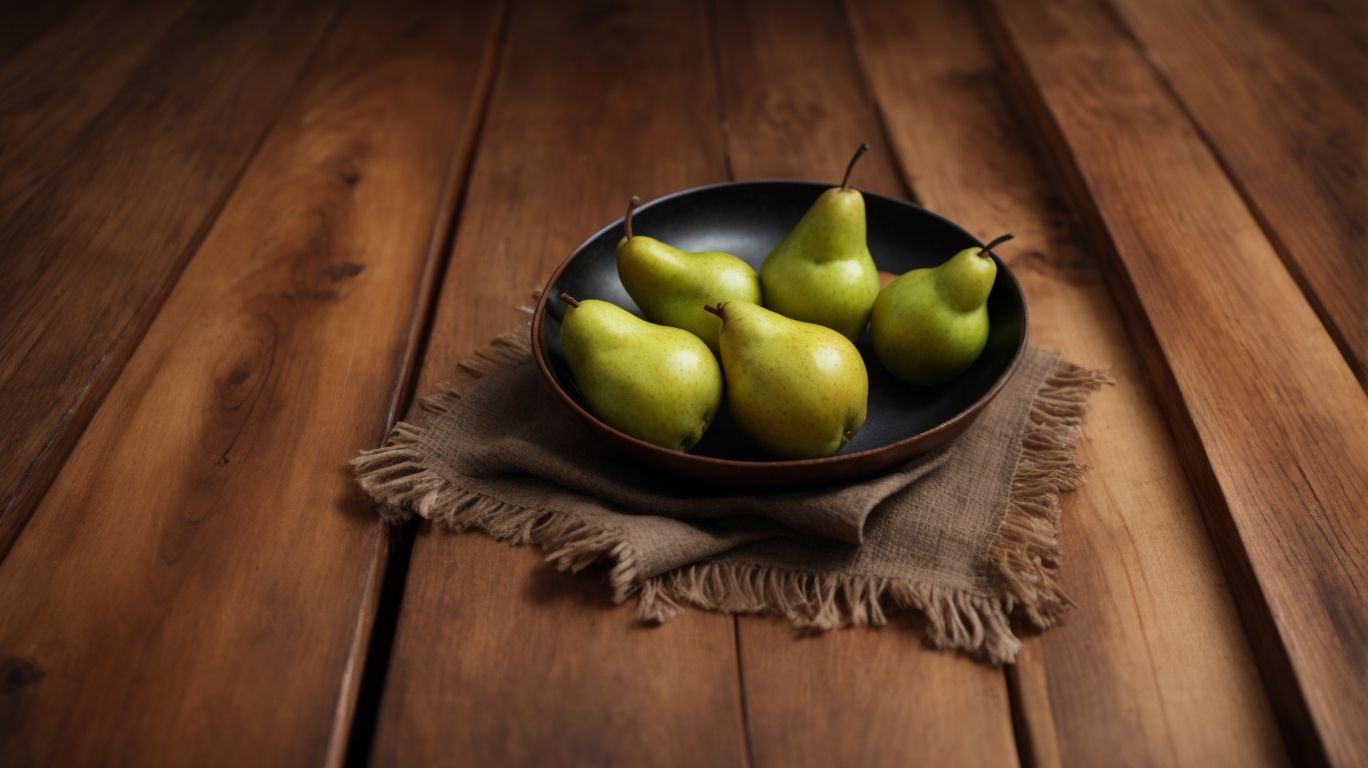
Credits: Poormet.Com – Christopher Moore
Determining the ripeness of a pear involves assessing its firmness, as unripe pears tend to be firmer and less yielding to gentle pressure.
When checking for ripeness, a ripe pear should yield slightly to pressure when gently squeezed near the stem, indicating juiciness and sweetness. In contrast, an unripe pear at room temperature will feel hard and dense, lacking the juicy characteristics of a fully ripe fruit.
A common variety such as the Bartlett pear, when unripe, will have a more pale green color and feel solid to the touch. As it ripens, the Bartlett pear shifts to a yellowish hue and softens, giving off a fragrant aroma.
What Types of Pears are Best for Baking?
In terms of baking pears, varieties like Bosc and Anjou are highly recommended for their firm texture and sweet flavor, ideal for withstanding the baking process.
Bosc pears are particularly prized for baking due to their dense flesh that holds up well to heat without disintegrating, while imparting a lovely honeyed sweetness to the dish. Their subtle vanilla undertones enhance the overall flavor profile when paired with classic baking ingredients like sugar and vanilla extract.
On the other hand, Anjou pears provide a more delicate sweetness with a slight citrusy note, making them versatile for both sweet and savory baking recipes. Their juiciness ensures a moist and flavorful outcome, especially when combined with warm spices like cinnamon or nutmeg.
Bosc Pears
Bosc pears are a popular choice for baking due to their dense and crisp texture, which holds up well during the baking process, retaining both shape and flavor.
Known for their sweet and slightly spiced flavor, Bosc pears add a delicate taste to any baked dish. The firm texture of Bosc pears makes them ideal for baking as they soften but maintain their structure when heated, creating a pleasing contrast in both sweet and savory recipes.
- Their earthy undertones and honeyed aroma elevate the taste of desserts, such as pies, crisps, and tarts, providing a luscious and aromatic profile.
- When paired with cinnamon, nutmeg, or cloves, Bosc pears offer a warmth that complements the richness of baked goods, bringing out their natural sweetness.
Preparation-wise, Bosc pears are easy to peel and slice, perfect for layering in a bake or incorporating into a dish for a delectable and visually appealing outcome.
Anjou Pears
Anjou pears, with their juicy and sweet flesh, are excellent for baking purposes, delivering a burst of natural sweetness and moisture to baked dishes.
When selecting Anjou pears for your baking recipes, it is crucial to choose ripe fruits that yield slightly to gentle pressure near the stem. This indicates that they are ready for use and will enhance the flavors of your creations. Anjou pears are renowned for their subtle flavor profile, which blends hints of citrus and floral notes, adding a delicate touch to your baked goods. Their firm texture holds up well to heat, making them ideal for pies, tarts, crumbles, and even as a topping for desserts like ice cream or yogurt.
Whether you enjoy them fresh as a snack, diced for a fruit salad, or as a delightful addition to a baby spinach salad, Anjou pears are versatile and delicious in any form. Try caramelizing or roasting pear halves with a sprinkle of cinnamon for a delectable treat that will elevate your baking to a new level of sophistication.
Comice Pears
Comice pears, known for their buttery texture and delicate sweetness, are a delightful choice for baking applications, imparting a rich and luxurious taste to desserts.
When contemplating the perfect variety of pears to use in your baking adventures, the Comice pear stands out for its ability to hold up well to heat, maintaining its juiciness and flavor even after being subjected to temperatures as high as 180°C. The unique taste of Comice pears, with hints of honey and citrus, adds a refreshing twist to traditional baked goods.
How to Prepare Unripe Pears for Baking?
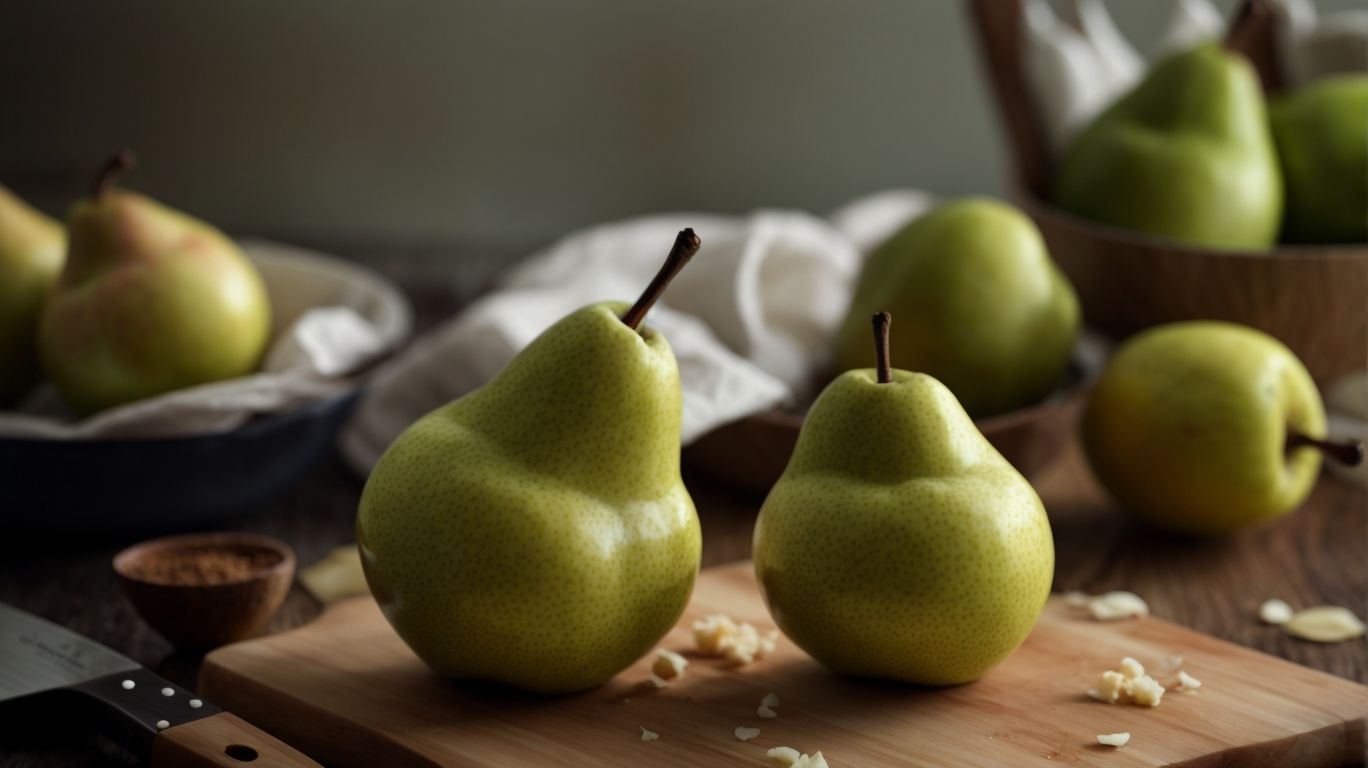
Credits: Poormet.Com – James Thompson
Preparing unripe pears for baking involves essential steps such as peeling, coring, and slicing to ensure even cooking and optimal flavor infusion.
Start by peeling the unripe pears using a sharp peeler, ensuring to remove all the tough skin. Once peeled, carefully core the pears using a corer tool or a small knife to get rid of the seeds and tough center. For slicing, cut the pears into even slices of around 1/4 inch thickness to promote uniform cooking. Sprinkle the slices with a teaspoon of cinnamon powder for a warm and aromatic flavor boost.
Peeling
Peeling unripe pears is a crucial step in preparing them for baking, as it enhances the texture and allows for better absorption of flavors during the baking process.
When the pear is unripe, the skin can be tough and bitter, affecting the overall taste and mouthfeel of the baked dish. By carefully peeling the pears, you not only remove the unwanted skin but also cut down on any potential bitterness. This exposes the flesh, allowing it to sliver down into tender, succulent bites as it bakes. Peeling before baking ensures that the pears cool evenly and absorb the flavors from your chosen seasonings or sauces, resulting in a harmonious blend of tastes.
Coring
Coring unripe pears involves removing the seeds and inner core to create a hollow cavity that can be filled with delicious ingredients for baking.
To core unripe pears effectively, you will need to gently slice the pear in half lengthwise, exposing the inner flesh and the small cluster of seeds at the core. Using a spoon or a melon baller, carefully scoop out the seeds and fibrous core, creating a nice hollow space that is perfect for filling with a scrumptious mixture of your choice. This method ensures that the pears remain tender while baking, allowing the flavors of the ingredients to meld together beautifully.
Slicing
Slicing unripe pears into uniform pieces ensures even cooking and consistent texture throughout the baked dish, enhancing both presentation and taste.
When preparing unripe pears for baking, it is essential to peel and core them before slicing. Uniform cuts not only help the fruit cook evenly but also allow for a harmonious distribution of flavors. The consistent size of the pieces ensures that the pears soften and caramelize uniformly during the baking process. This meticulous approach to slicing will enable the fruit to blend seamlessly with other ingredients, such as nuts, to create a delectable and visually appealing baked dessert or dish.
What Are Some Recipes for Baking Unripe Pears?
Explore delectable recipes for baking unripe pears, such as Baked Pears with Cinnamon and Honey, Pear and Almond Tart, and Pear and Ginger Crumble, offering a delightful balance of flavors and textures.
In terms of baking unripe pears, the key is to choose firm and slightly underripe fruit for the best results. For the Baked Pears with Cinnamon and Honey, simply core the pears, sprinkle with a mixture of cinnamon and honey, and bake until tender. The aroma of warm cinnamon paired with sweet honey makes this dish an easy and elegant dessert option.
For the Pear and Almond Tart, a buttery crust filled with frangipane and thinly sliced pears creates a decadent treat that’s perfect for special occasions. The combination of crunchy almonds and fragrant pears is a true delight for the senses.
Alternatively, the Pear and Ginger Crumble offers a comforting serving of baked fruit topped with a crunchy and nutty crumble. The spice of ginger adds a zingy twist to this classic dessert, making it a wonderful choice for cozy nights in.
Baked Pears with Cinnamon and Honey
Baked Pears with Cinnamon and Honey offer a harmonious blend of warm spices and natural sweetness, creating a comforting and aromatic dessert perfect for any occasion.
If you’re looking for a simple yet elegant dessert idea, these baked pears are sure to impress your guests. To start, choose ripe but firm pears such as Anjou or Bosc. Slice them in half lengthwise, and core each half to make room for the delicious filling.
Next, sprinkle a generous amount of ground cinnamon over the pears, drizzle with honey for that delightful sweetness, and add a few knobs of plant-based butter for a rich flavor. The magic happens in the oven as the pears soften and caramelize, releasing their natural juices and absorbing the fragrant spices.
Pear and Almond Tart
The Pear and Almond Tart combines the delicate sweetness of ripe pears with the nutty richness of almonds, creating a delightful dessert that pairs beautifully with a scoop of vanilla ice cream.
This classic French dessert is a perfect blend of flavors and textures. The juicy slices of cinnamon-baked pears are arranged on a crisp, buttery pastry base, topped with a layer of creamy yogurt infused with a hint of cinnamon for a touch of warmth. The sprinkling of toasted almonds adds a crunch that contrasts beautifully with the tender pears. Each bite is a symphony of sweet, nutty, and aromatic notes that will satisfy even the most discerning palate.
Pear and Ginger Crumble
The Pear and Ginger Crumble offers a comforting blend of sweet pears and spicy ginger, topped with a crispy crumble topping for a delightful contrast of textures and flavors.
When making this dessert, the roasted pear essence combined with the zesty punch of ginger creates a flavorful symphony that is hard to resist.
The best part about this recipe is that not only is it a delicious treat, but it is also relatively simple to put together. The process involves layering the pear and ginger mixture in a baking dish, then generously sprinkling the crumble topping over it to create that perfect balance between sweetness and spice.
Tips for Baking Unripe Pears
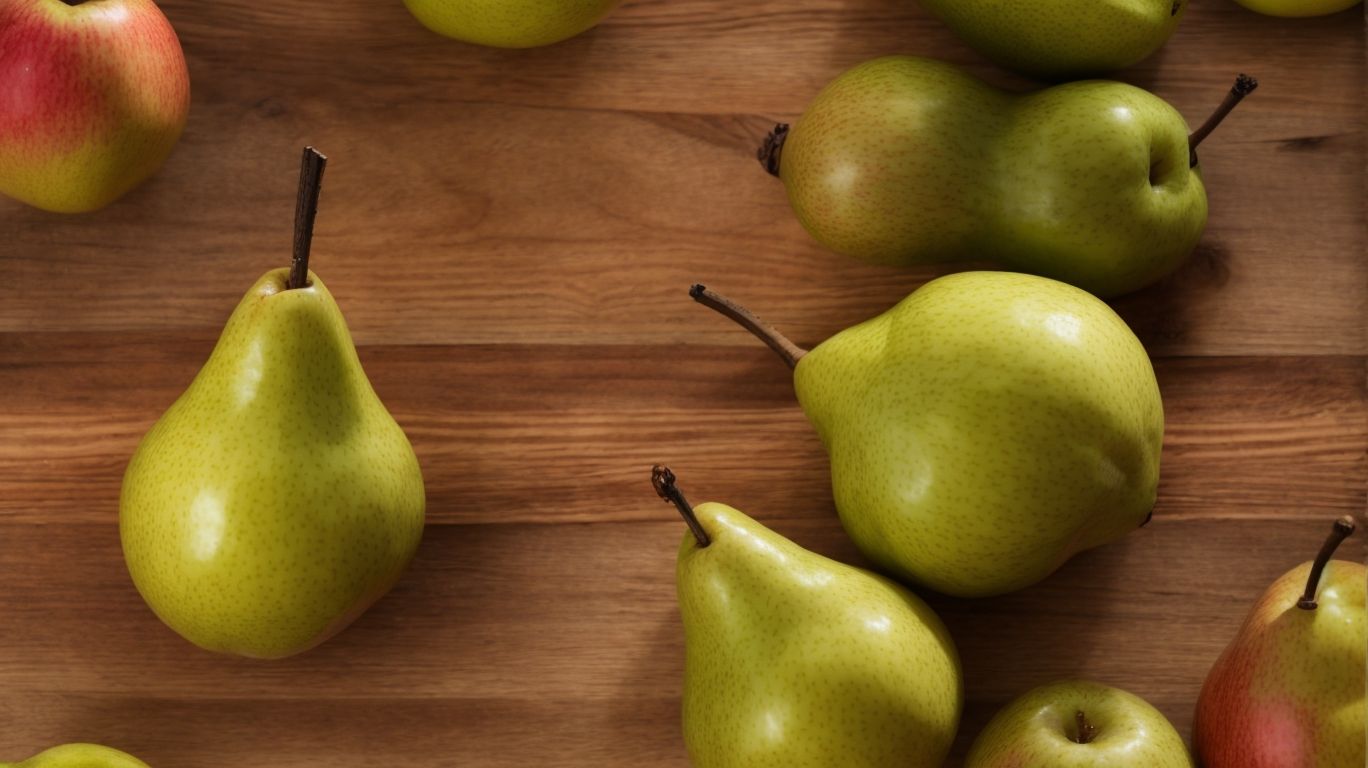
Credits: Poormet.Com – Carl Baker
Discover essential tips for baking unripe pears to perfection, including adding citrus juice for brightness, using a sweetener to enhance natural flavors, and incorporating aromatic spices for depth and complexity.
In terms of selecting a sweetener for your baked pears, consider options like honey, maple syrup, or brown sugar to impart a caramelized richness. The choice of sweetener can greatly influence the overall taste profile of the dish.
Don’t forget about the cooking time; ensure you bake the pears until they are tender but still hold their shape to maintain a balance between softness and firmness.
For a truly delectable treat, serve the baked pears warm with a dollop of vanilla ice cream or a drizzle of syrup for added indulgence.
Add Citrus Juice
Adding citrus juice to baked unripe pears imparts a refreshing tang and balances the natural sweetness, enhancing the overall flavor profile of the dish.
The acidity of citrus juice not only adds a zesty kick to the pears but also helps cut through any potential richness, bringing a harmonious contrast to the dessert. When combined with a hint of honey and a touch of vanilla, the flavors meld together, creating a decadent yet balanced treat.
The citrus juice serves as a natural tenderizer, ensuring the pears are perfectly cooked and tender. When ready, serve these delectable baked pears warm, topped with a dollop of vanilla ice cream or a drizzle of honey for a delightful finishing touch.
Use a Sweetener
Incorporating a sweetener like honey or maple syrup when baking unripe pears intensifies their natural sweetness, creating a luscious and indulgent dessert experience.
When selecting a sweetener for these baked unripe pears, it is not only about enhancing the flavor but also considering the level of sweetness desired. Honey offers a rich and floral sweetness that beautifully complements the slightly tart notes of the pears, while maple syrup adds a deep, caramel-like sweetness.
If you’re specifically making a treat for a baby, you may opt for a natural sweetener like date paste or mashed banana to keep it healthy and sugar-free. These alternatives provide a gentle sweetness suitable for tiny taste buds.
Experimenting with different sweeteners can open up a world of flavor possibilities for your baking. Whether you choose agave nectar, coconut sugar, or stevia, each sweetener brings its unique taste and sweetness level to the method.
Add Spices
Incorporating aromatic spices like cinnamon and nutmeg when baking unripe pears elevates the dish with warm undertones and a cozy fragrance, enhancing the overall sensory experience.
The preparation process involves lightly coating the unripe fruit with a layer of melted butter before sprinkling a balanced mixture of cinnamon, nutmeg, and other spices on top. This infusion complements the natural sweetness of the pears, creating a harmonious blend of flavors. As the fruit bakes, the spices intermingle, releasing their distinctive aromas and infusing the pears with warmth and depth. The result is a tender, flavorful treat that delights the taste buds and fills the kitchen with a mouthwatering scent.
Why Bake Unripe Pears?
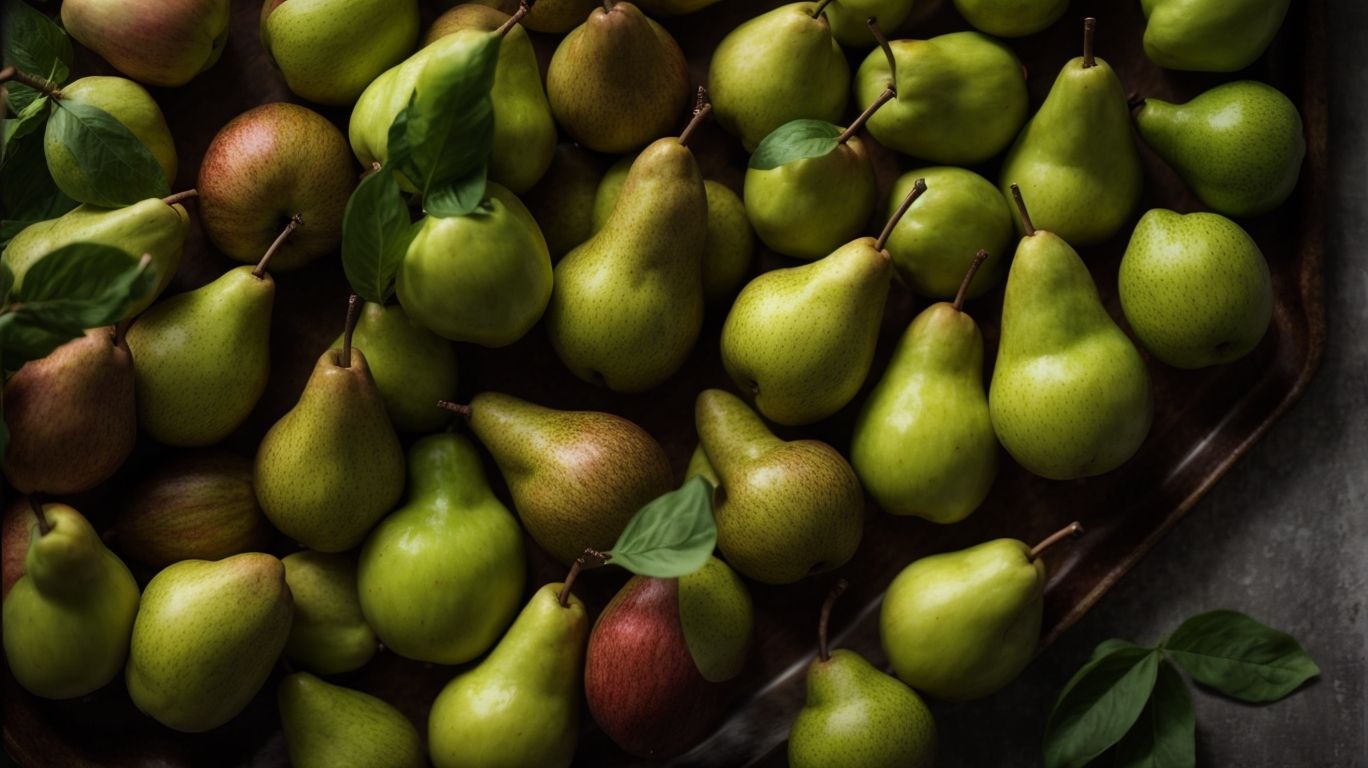
Credits: Poormet.Com – Jordan Lee
Baking unripe pears can transform their texture and flavor, turning them into delicious treats suitable for various recipes and occasions.
When unripe pears are baked, the heat caramelizes their natural sugars, enhancing their sweetness and creating a perfect harmony with the warm notes of cinnamon. The pears’ flesh softens during baking, resulting in a tender consistency that is ideal for both sweet and savory dishes. Adding a drizzle of rich maple syrup and a sprinkle of crunchy pecans before baking can elevate the flavor profile, adding depth and a delightful crunch to each bite.
How to Tell if a Pear is Unripe?
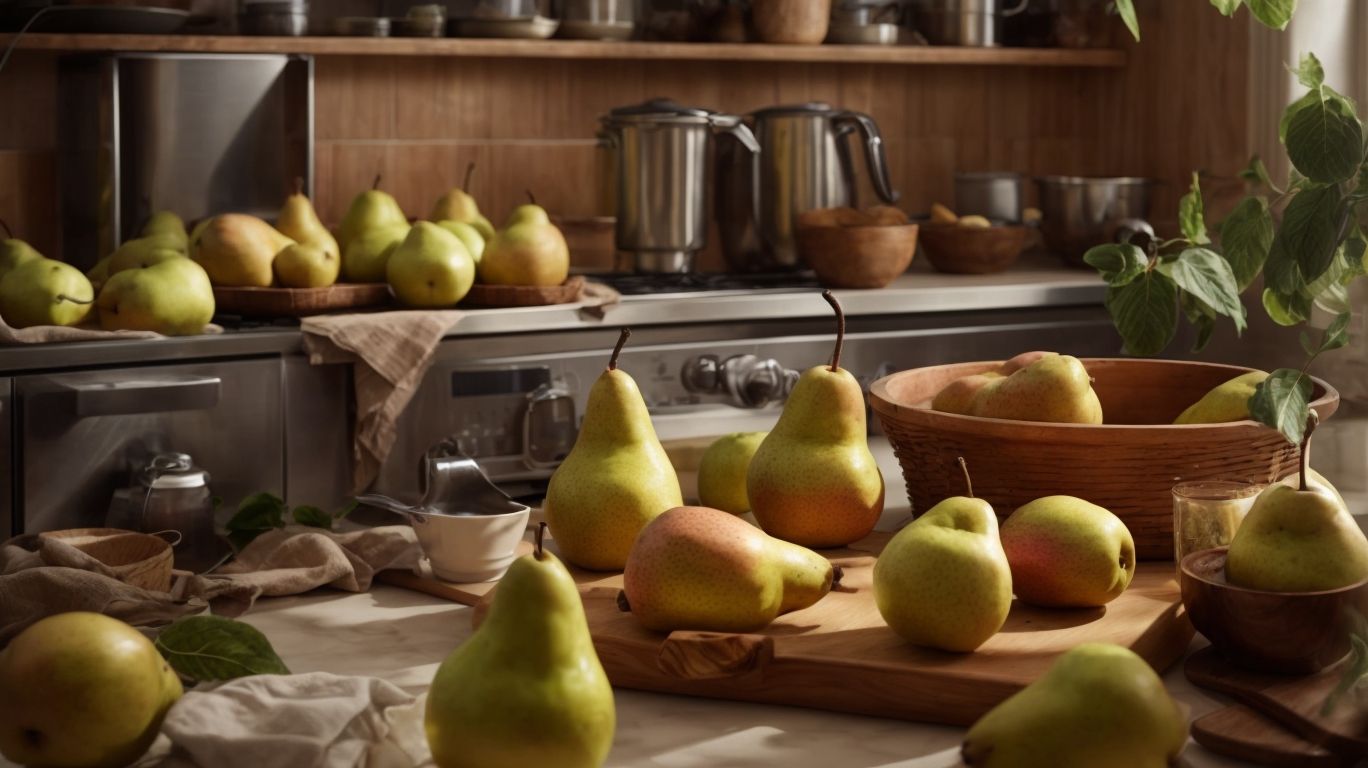
Credits: Poormet.Com – William Torres
Determining the ripeness of a pear involves assessing its firmness, as unripe pears tend to be firmer and less yielding to gentle pressure.
When you gently squeeze a pear, an unripe one will feel hard to the touch and won’t give much under pressure. This contrasts with a ripe Bartlett pear, which will be slightly soft around the stem and yield when pressed gently.
What Are Some Recipes for Baking Unripe Pears?
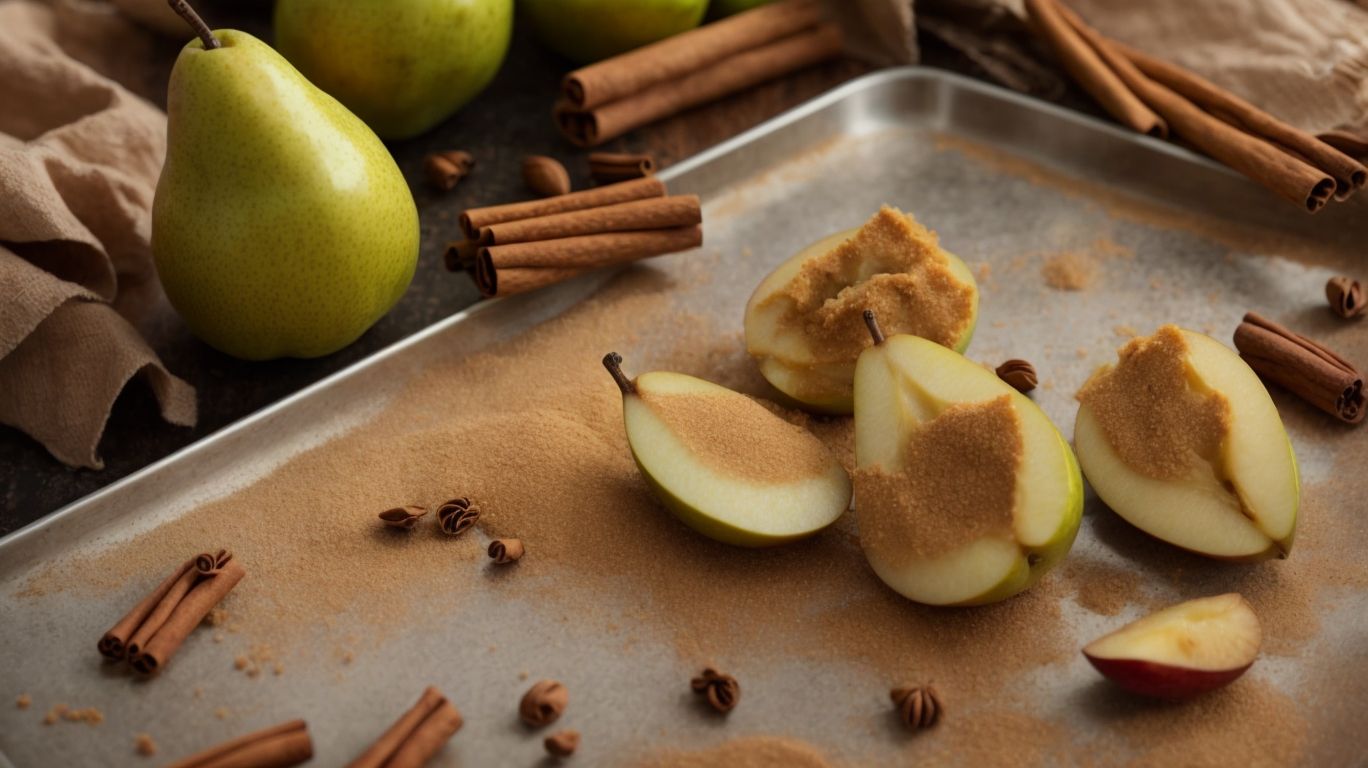
Credits: Poormet.Com – Wayne King
Explore delectable recipes for baking unripe pears, such as Baked Pears with Cinnamon and Honey, Pear and Almond Tart, and Pear and Ginger Crumble, offering a delightful balance of flavors and textures.
If you are looking for an easy yet impressive dessert, try these baked pears. Simply core the unripe pears, drizzle them with honey, sprinkle some cinnamon, and bake until tender. The result is a warm, comforting treat that is perfect for autumn nights.
For a more decadent option, opt for the pear and almond tart with a buttery crust filled with almond frangipane and glazed pears on top. The combination of sweet pears and nutty almonds is a match made in heaven.
In terms of serving these delightful creations, consider adding a scoop of vanilla ice cream or a dollop of whipped cream to complement the flavors. To elevate the experience further, customize your dishes by adding a handful of toasted nuts like walnuts or pecans for a delightful crunch.
Whether you are hosting a dinner party or simply craving something sweet, these baked fruit desserts are sure to impress your guests and satisfy your cravings.
Frequently Asked Questions
What are some tips for baking unripe pears?
To successfully bake unripe pears, I recommend using a baking method that involves adding moisture, such as poaching, to help soften the fruit. You can also mix in ripe pears or other fruit to help balance the flavors.
How long does it take to bake unripe pears?
The baking time for unripe pears will depend on the ripeness and size of the fruit, as well as the recipe you are using. Generally, it can take anywhere from 25-45 minutes at 375°F. Keep an eye on the pears and check for tenderness with a fork.
Can I use unripe pears for any type of baked dessert?
Yes, you can use unripe pears in a variety of baked desserts, such as pies, tarts, crisps, and cakes. Just make sure to adjust the recipe and baking time accordingly to account for the firmness of the fruit.
How can I tell if a pear is ripe enough to bake?
If the pear is slightly firm but gives slightly when pressed, it is ripe enough to bake. Avoid using pears that are rock hard or mushy. You can also use a paring knife to cut a small slice from the pear to check its texture.
Do I need to peel unripe pears before baking?
It is not necessary to peel unripe pears before baking, especially if you are using a baking method with added moisture. However, if you prefer a smoother texture, you can peel the pears before baking.
Can I use unripe pears for savory dishes?
Yes, unripe pears can be used in savory dishes as well, such as salads, chutneys, and glazes for meats. Just make sure to adjust the seasonings and ingredients to balance out the tartness of the unripe pears.

